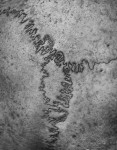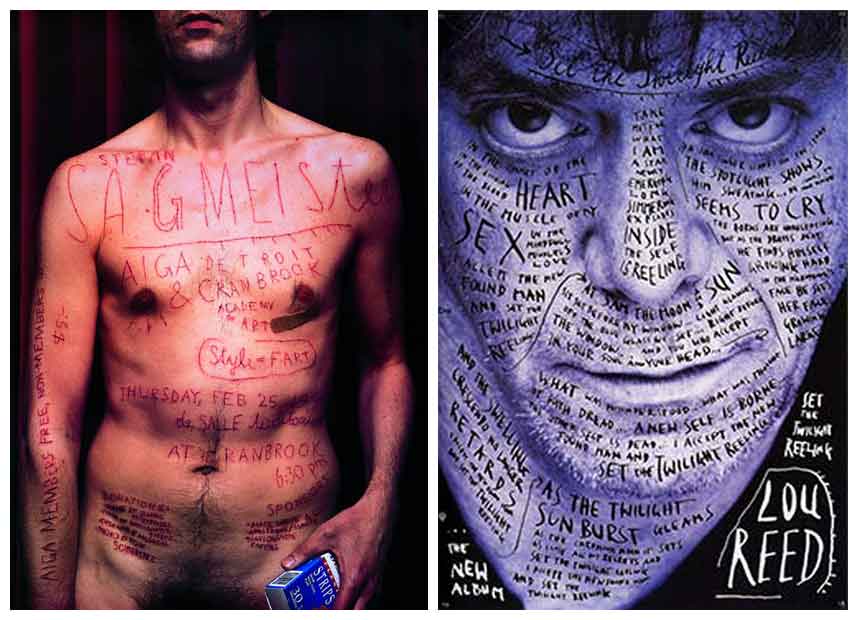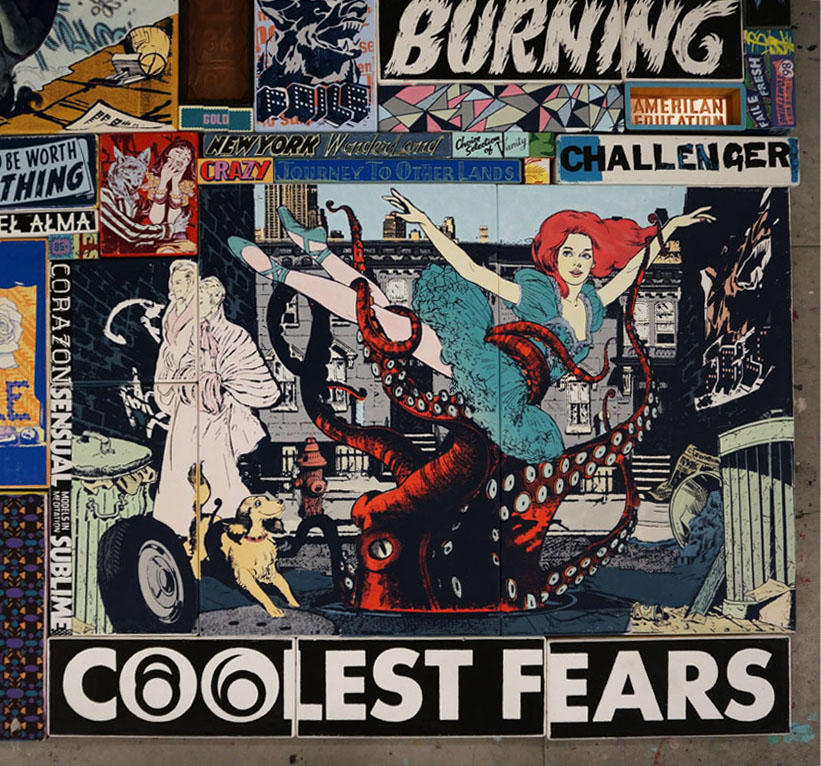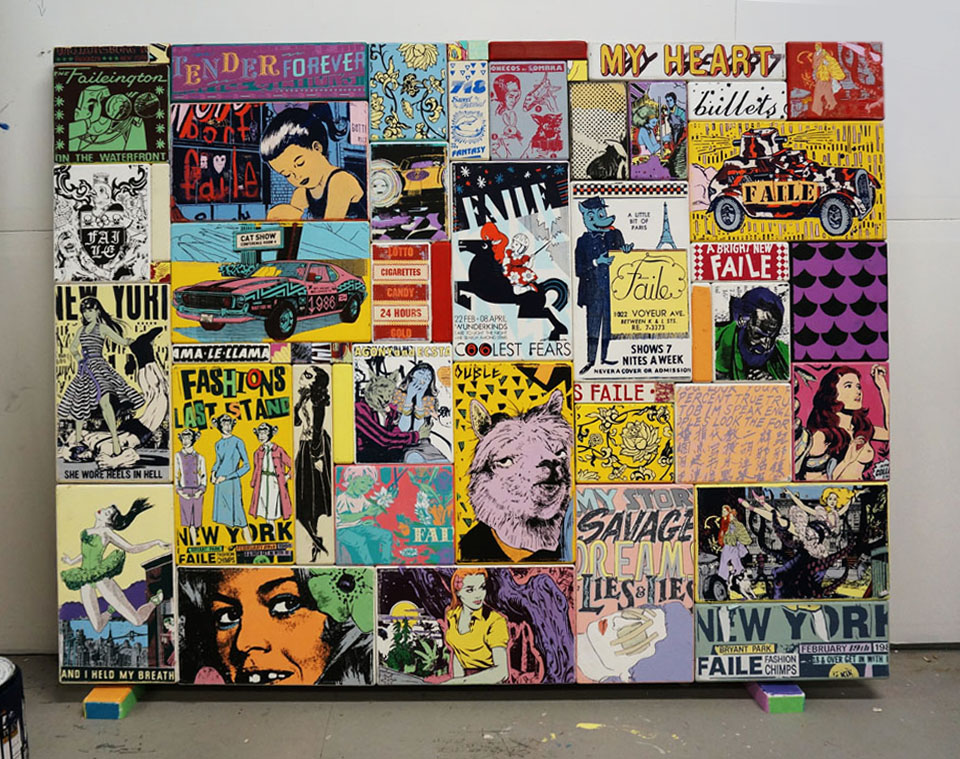Well, I have no deep thoughts on the world of art to share at the moment, so here’s a new double spread, playing with some different styles of shading and patterning in my sketchbook.
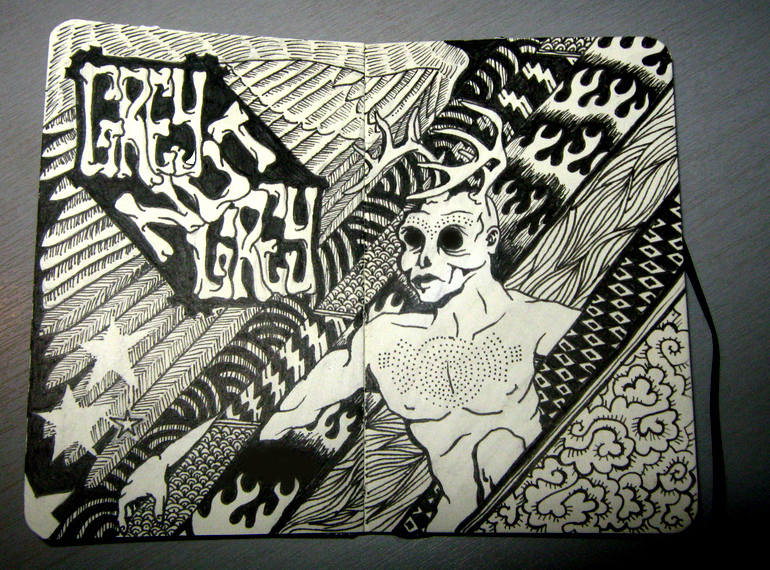
If you’re similarly inclined, you can always get a Moleskine Sketchbook for yourself.
As a teenager I lived in downtown Hamilton, Ontario. A couple of blocks from my house was King Street, the main east-west corridor through the heart of downtown. In my neck of the woods was what the city fathers dubbed “the International Village” which is mostly gone now, but at the time it consisted of a Chinese Restaurant, a German deli, a German restaurant, and a German-language bookstore. The bookstore was one of the first casualties of the area’s economic decline in the 80s and they were selling off books cheap – as I had picked up some German from high school classes, I wandered in. I picked up a great large-format book of black and white photographs by Andreas Feininger called das Antlitz der Natur (published in English as the Anatomy of Nature), a collection mostly of skeletal anatomy photos. Many of the pictures had appeared in LIFE magazine in 1951, perhaps unsurprisingly as Feininger was a staff photographer for LIFE at the time. Feininger is best known for artistic nudes and architecture like New York in the 40s, but I didn’t know that at the time – I was simply enthralled by das Antlitz der Natur.
- human skull
- skeletal structure and teeth
- skeletal structure of a young monkey’s thin skull
- human skull
- cat, raccoon and human skulls
- cat and raccoon skulls
As it happens, over the years I have amassed a skull collection of my own. A few years back I was paging through the Feininger book and thought I’d try some photos of my own using whatever small lights I had around the house. I took a metric heckload of shots, but these are my three favourites:
- human skull
- cat, raccoon and human skulls
- cat and raccoon skulls
I’m pretty pleased with how they turned out. So yeah, take inspiration from what’s around you. If you’re interested in trying this at home, pick up a copy of das Antlitz der Natur (or the Anatomy of Nature if you prefer) for reference, and start setting up the lights! It doesn’t have to be skulls, of course, but they really are awfully attractive forms.
If you follow graphic design at all, Stefan Sagmeister is probably a familiar name. To say that he is a big deal would be putting it mildly.
Stefan Sagmeister has worked for the Rolling Stones, The Talking Heads, Lou Reed, and The Guggenheim Museum. Exhibitions on Sagmeister’s work have been mounted in New York, Philadelphia, Tokyo, Osaka, Seoul, Paris, Lausanne, Zurich, Vienna, Prague, Cologne & Berlin.
– Sagmeister & Walsh
Sagmeister was born in Austria and has been a New Yorker on and off since getting a Fulbright scholarship to Pratt in ’87. On graduating, he did 3 years of compulsory service in Austria. In ’91 he got a job as a typographer working for Leo Burnett in Hong Kong, then in ’93 he returned to NYC to work with Tibor Kalman‘s agency, M&Co. When Kalman closed up shop, Sagmeister formed Sagmeister Inc. (recently rebranded as Sagmeister & Walsh) where he produced some of the best graphic design work to come out of the 90’s.
Sagmeister is well known for posters, for instance, as in the iconic (and award-winning) examples shown below.
I recently learned about Sagmeister’s work with Hillman Curtis, the respected and sadly recently deceased designer-turned-filmmaker.
Curtis is perhaps best known for his popular Artist Series, which was ongoing from 2005 and featured designers like Milton Glaser, Paula Scher, and David Carson.
His latest project, The Happy Film, is a feature-length film [that] was in production at the time of his death.
– Obituary from idsgn.com
So yeah, a great movie loosely based on Things I Have Learned in My Life So Far by Sagmeister about… happiness? Well, sort of.
“The Happy Film” centers around our main subject, Stefan Sagmeister, a New York-based graphic designer known for his rock n roll collaborations and typography. In the course of a year, Sagmeister will experiment with various practices that are widely touted as increasing one’s happiness: meditation, cognitive therapy, and pharmaceuticals.
The documentary will test these various methods during 3 x 3-month experiment periods. The production team will work closely with a group of health professionals to properly assess Sagmeister’s well-being. Our health partners will monitor Stefan prior to the experiments, as well as participate in occasional check-ups during the course of our 9-month study.
Throughout the film, Sagmeister’s maxims, by way of the book “Things I Have Learned in My Life So Far”, will function as typographical set pieces that related to the ongoing experiments.
– from The Happy Film kickstarter
Wait, what? A Kickstarter link? That’s right. Basically when Curtis died, the film was about 40% shot and quite frankly had run out of money, so the production company and Sagmeister decided to try crowdfunding through Kickstarter.
For those of you unfamiliar with Kickstarter, here’s the down-low:
Thousands of creative projects are funding on Kickstarter at any given moment. Each project is independently created and crafted by the person behind it. The filmmakers, musicians, artists, and designers you see on Kickstarter have complete control and responsibility over their projects. They spend weeks building their project pages, shooting their videos, and brainstorming what rewards to offer backers. When they’re ready, creators launch their project and share it with their community.
Every project creator sets their project’s funding goal and deadline. If people like the project, they can pledge money to make it happen. If the project succeeds in reaching its funding goal, all backers’ credit cards are charged when time expires. If the project falls short, no one is charged. Funding on Kickstarter is all-or-nothing.
–kickstarter.com
Sounds great, right? The neat thing about the Kickstarter platform besides allowing creatives to crowdfund is that to incentivize contributions, the creatives create rewards for pledge tiers. For instance…
Pledge $500 or more
Stefan will pick you up on the North East corner of Tompkins Square Park (New York City) in a 1968 Firebird Convertible (it’s a rental!) and you’ll drive through Manhattan in the rain playing his 10 favorite songs. In case it does not rain he’ll bring a water gun. You will be dropped off at a random street corner and he will speed away.
I first saw Maskull Lassere’s sculptures in 2011 at an art gallery in the Belgo Building in downtown Montreal. To tell the truth I saw a photo of one of his pieces on Colossal and got so excited I rushed straight over on my lunch break.
His snake skeleton axe entitled Secret Carpentry is one of the most superb sculptural objects I’ve ever seen and don’t miss his work with computer software manuals,newspapers, coat hangers, and tree branches. Lasserre is currently part of a group exhibition at the Pierre-François Ouellette art contemporain (PFOAC) in Montreal through August 6, followed by a solo show in the same space starting in November.
– Colossal
It was pretty interesting work, carving intricate skeletal details out of bits of furniture and other household items, like this piece where he carved the lower jaw of a child into the corner of a picture frame.
Anyhow, to be honest I kind of forgot about Lasserre which is rather shameful as not only do I really like his work, but he is Montreal artist and even has his studio in my neighbourhood. My reminder came yesterday via booooooom in the form of an excellent post about Lasserre’s newest work, a series entitled “Fable”, which I am quite taken with – especially this piece, “Rat”.
I really enjoy Lasserre’s repurposing of everday objects into these delicate, intricately detailed memento mori-ish sculptures. Beyond the artistic mastery of it all, I have enjoyed a lifelong fascination with skeletal anatomy so these works speak to me on a very personal level. The transformative aspect of Lasserre’s work is intriguing, too, and is discussed briefly in an interview in Canadian Art last year:
His themes are what he terms “elemental,” which partially explains their dramatic appeal. Lasserre examines death, music, literature, beauty, pain, purpose and integrity (both structural and philosophical) through eerily complex representations of transformed tools, skeletons and animal parts that indicate a mastery of welding, forging, mechanical engineering, musical-instrument design and weapons making. Some of his pieces have incredible heft—he builds full-size pianos—while others are fragility embodied. One recent work, Murder (2012), features 19 crows and ravens he sculpted out of wood and then charred so that they disintegrate at the merest touch. It was exhibited in a group show at New York’s Museum of Arts and Design earlier this year, along with a work by Andy Goldsworthy.
– Canadian Art
In any case I’m definitely going to make the effort to keep Lasserre on my radar, as I’m really looking forward to seeing these new pieces in person. More of Lasserre’s work can be seen on his website. In parting, I leave you with this video of the artist a work via an interview from the Daily Mail (UK) .
http://vimeo.com/4356872
So I was checking out Arrested Motion today and it would seem that FAILE are continuing to be as productive as ever. Apparently they are doing some kind of collaborative work with the New York City Ballet (?!)
NYCB Art Series commissions contemporary artists to create original works of art inspired by our unique energy, spectacular dancers, and one-of-a-kind repertory of ballets. New York City Ballet has worked with leading and emerging artists throughout the Company’s history — luminaries like Andy Warhol, Keith Haring, and Julian Schnabel. We are proud to continue this tradition by partnering with Brooklyn-based artists FAILE for the inaugural year of Art Series.
FAILE’s installation, Les Ballets De Faile, was created for the Art Series performances on Friday, February 1, and Wednesday, May 29. On these dates, every seat in the house is available for just $29, and each audience member will receive a limited-edition work made specifically for this event.
Uh, WOW. I would love to see that. If you’re in NYC this Friday with nothing awesome to do…
The other fun part of the Arrested Motion article was a behind-the-scenes look at the Brooklyn studio FAILE works out of.
Having looked at the NYCB page I see some familiar elements there, so maybe this is a bit of a sneak peek at what you might expect from the Art Series show. Here’s another taster:
So yeah, beautiful and inspiring work from FAILE as always… you could get a FAILE print of your very own PLUS see a performance by the NYCB for the low price of $29 this Friday. I mean seriously, $29 isn’t even enough to buy breakfast in Manhattan. OK, I exaggerate, but $29 is peanuts, f’reals.
For those of you who can’t make it to NYC this weekend, I’d normally recommend the FAILE website but it appears to be down right now, so there’s always books. My charming and talented wife picked me up a copy of Faile: Prints and Originals 1999-2009 and it’s a really fantastic overview of their work.


